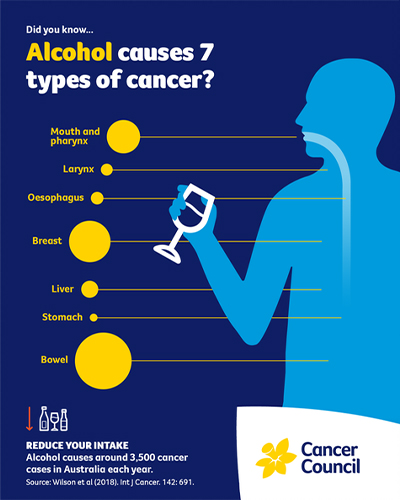I started a new role in the Alcohol Programs Team at Cancer Council WA recently. As an injury epidemiologist, I knew about how alcohol can be a risk factor for injury. However, like many Australians, I was surprised to learn that alcohol is also an important, but often overlooked, risk factor for cancer.
World Cancer Day on February 4 offers an opportunity to raise awareness of the link between alcohol and cancer, educate, and encourage personal, community and government action. In 1988, the World Health Organization, International Agency for Research on Cancer concluded that alcohol use is a group one carcinogen, meaning that it is a direct cause of cancer in humans.
What we know about alcohol and cancer?
- Around 5% of new cancers (741,000 cases) diagnosed worldwide in 2020 were directly attributable to alcohol use.
- Alcohol use has been connected to at least seven types of cancer, including: breast (females only), colorectal, liver, pharynx, larynx, oesophagus, and oral cavity.
- Alcohol is responsible for an increasing number of cancer cases in Australia each year, and in WA an average of three people die each week from alcohol-related cancers.
- The risk of developing some of these cancers is higher among people who smoke and drink alcohol.
- All types of alcoholic products increase the cancer risk. It doesn't make a difference if you're drinking beer, wine or brandy – alcoholic beverages all have one thing in common: they contain ethanol.
- No level of alcohol use is completely safe. The less alcohol you drink, the lower your risk of cancer.

How does alcohol increase your cancer risk?
While large-scale genetic studies, many led by Oxford Population Health, have confirmed that alcohol directly causes cancer; researchers and clinicians across the world are still studying exactly how alcohol increases cancer risk. Current evidence indicates that many factors contribute to how alcohol impacts different tissues. Our bodies break down the ethanol in alcohol by converting it to a compound called acetaldehyde. This is a known carcinogen that damages DNA. The formation of acetaldehyde can happen with any amount of alcohol. However, the more a person drinks, the higher the risk as people who drink at high risk levels produce much more acetaldehyde. This can result in greater toxic and carcinogenic effects.
Other mechanisms include:
- Alcohol makes it harder for the body to process and absorb important cancer protective nutrients, including antioxidants like folate and vitamins including vitamin A, B12, C, D and E.
- Regular use of alcohol often leads to increased body weight (a risk factor for cancer) due to the 'empty calories' alcohol contains.
- Alcohol can damage healthy cells in the mouth and throat. As these cells repair themselves, there may be DNA changes that can lead to cancer.
- Alcohol can make the carcinogens found in tobacco smoke easier for the body to absorb.
- Alcohol use raises the levels of the hormone estrogen, which can modify how cells in the breast grown and divide.
We must do more to raise awareness of the link between alcohol and cancer.
Surveys in Australia and internationally find that community awareness of the link between alcohol and cancers is low, even among health care providers.
Education campaigns are an effective way to improved community awareness. One successful campaign is the Alcohol and Health 'Glassbody' campaign, a joint initiative between the Mental Health Commission and the former McCusker Centre for Action on Alcohol and Youth. It encouraged people to reduce their drinking to reduce their risk of alcohol associated disease. The campaign led to an increase in the awareness of health harms from alcohol in people aged 25-54 years and a significant increase in campaign participants' belief that cancer and heart disease are associated with alcohol use.
If alcohol harm-reduction education campaigns are dependent on limited resources, and awareness of the link between alcohol and cancer in the community is low, what can we do as a community?
As someone with lived experience, a diagnosis of cancer is scary and comes with uncertainty and fear for the future. Survival rates for many cancers are improving due to new drugs and therapies, however, knowledge of the risks associated with cancer allows each of us to help ourselves and be proactive about managing our risk.
Our age, gender, genetics, reproductive history, and environmental exposures are all factors that contribute to the development of cancer. While we can't control our age, gender, or genetics; drinking alcohol is a risk factor that we can influence and take steps to control.
Let's take action together.
This is a call to action for the community to expect more. What can each of us as individuals do?
If information is available about the link between alcohol and cancer, but awareness is low, what can we do to get the evidence on alcohol and cancer promoted more widely?
An important step is to appeal to our political leaders. After all, the issues important to us should be the ones our politicians are focused on.
How to appeal to our political leaders
- Write to your local state and federal politicians
- Make an appointment to see them
- Let them know your personal narrative of alcohol and cancer
- Make sure they know you're concerned about the link between alcohol and cancer and that you would like to see our governments do more






